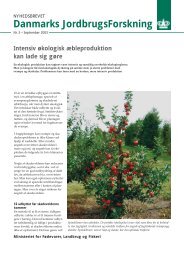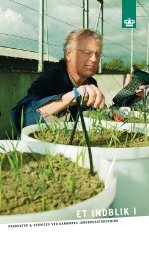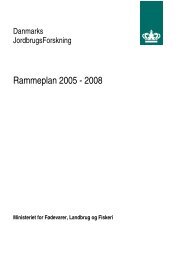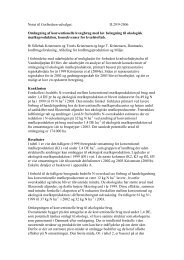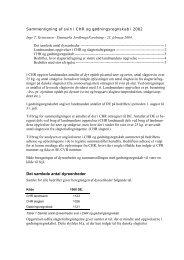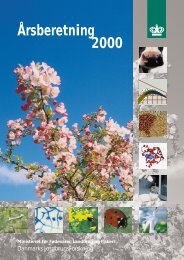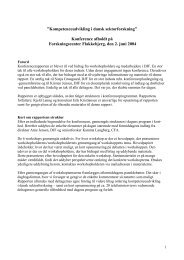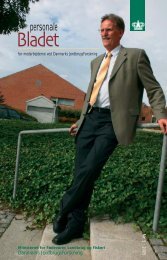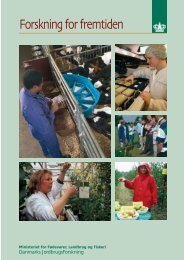Reproduction performances and conditions of group-housed non ...
Reproduction performances and conditions of group-housed non ...
Reproduction performances and conditions of group-housed non ...
Create successful ePaper yourself
Turn your PDF publications into a flip-book with our unique Google optimized e-Paper software.
- Paper III -<br />
1. Introduction<br />
The number <strong>of</strong> <strong>group</strong> <strong>housed</strong> <strong>non</strong>-lactating sows is increasing rapidly in Europe as a consequence<br />
<strong>of</strong> changed EU legislation (Council Directive 2001/88/EC amending Directive<br />
91/630/EEC Laying Down Minimum St<strong>and</strong>ards for the Protection <strong>of</strong> Pigs) combined with<br />
extraordinary national laws (Baustad & Lium, 2002; The welfare <strong>of</strong> Farmed Animals (Engl<strong>and</strong>)<br />
(Amendment) Regulations 2003).<br />
However, since individual housing <strong>of</strong> sows has been the far most common system in commercial<br />
sow herds for many decades, most <strong>of</strong> the information available about sows’ production<br />
<strong>and</strong> condition arrives from studies with individual housing. Although the amount <strong>of</strong><br />
scientific work related to <strong>group</strong> housing <strong>of</strong> sows has increased markedly in the last ten<br />
years, there is still a lot <strong>of</strong> unanswered questions concerning the function <strong>of</strong> the sows in<br />
commercial herds with <strong>group</strong> <strong>housed</strong> <strong>non</strong>-lactating sows.<br />
Several experimental studies indicated that <strong>group</strong> housing <strong>of</strong> sows might lead to individual<br />
variation in feed intake, social stress, <strong>and</strong> fear (reviews by Kongsted, 2004ab). This may<br />
constitute a welfare problem <strong>and</strong> in addition affect the reproduction results negatively (reviews<br />
by Kongsted, 2004ab). Most <strong>of</strong> the studies referred to in the mentioned reviews were<br />
performed under <strong>conditions</strong> that did not always reflect those circumstances seen in practice<br />
which are large <strong>group</strong> sizes (Nielsen et al., 2000), high stocking rates (Svendsen et al.,<br />
1990), constant introduction <strong>of</strong> new sows into dynamics <strong>group</strong>s (Svendsen et al., 1990),<br />
slippery floors (Hansen & Kongsted, 2002) <strong>and</strong> sows with locomotion problems (Gjein &<br />
Larssen, 1995; Nielsen et al., 2000; Hansen & Kongsted, 2002).<br />
In a few Danish on-farm experiments, level <strong>and</strong> variation <strong>of</strong> indicators <strong>of</strong> feed intake expressed<br />
as growth rate (Fisker, 1994; Nielsen, 1995; Fisker, 1999; Hansen, 2000) <strong>and</strong> stress<br />
expressed as adrenocortical response to additional stressors (Jensen et al., 1995) in <strong>group</strong><br />
<strong>housed</strong> sows has been assessed. However, systematic information <strong>of</strong> variation in feed intake,<br />
fear <strong>and</strong> social stress in sows <strong>group</strong> <strong>housed</strong> in the entire <strong>non</strong>-lactating period under<br />
various <strong>conditions</strong> are lacking. This is most likely, to some extent, because traditional<br />
methods for assessing these factors are expensive <strong>and</strong>/or time-consuming <strong>and</strong> therefore<br />
difficult to employ under practical <strong>conditions</strong> in large scale. First <strong>of</strong> all, it is therefore necessary<br />
to identify indicators <strong>of</strong> energy intake, stress <strong>and</strong> fear suitable for use in practice.<br />
Based upon existing knowledge, a suggestion for such indicators has been put forward in<br />
Kongsted (2004a). However, whether these indicators are suitable for use in <strong>group</strong> <strong>housed</strong><br />
sows under various on-farm <strong>conditions</strong> is not known.<br />
On this background the aim <strong>of</strong> this study is 1) to evaluate indicators believed to be suitable<br />
to gain information <strong>of</strong> variation in feed intake, social stress <strong>and</strong> fear in <strong>non</strong>-lactating sows<br />
61




